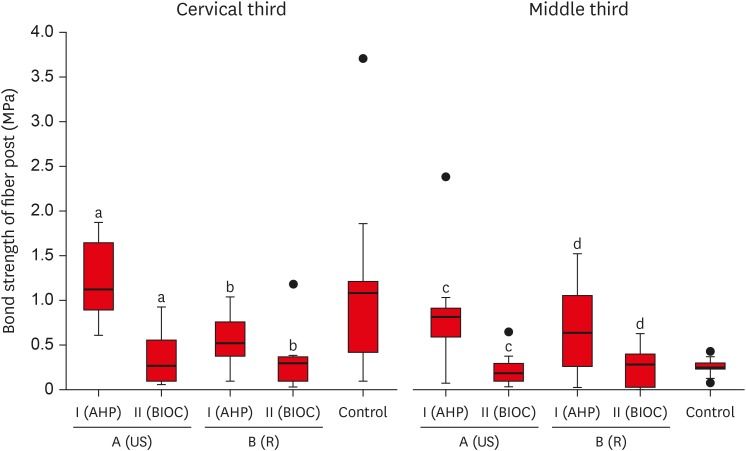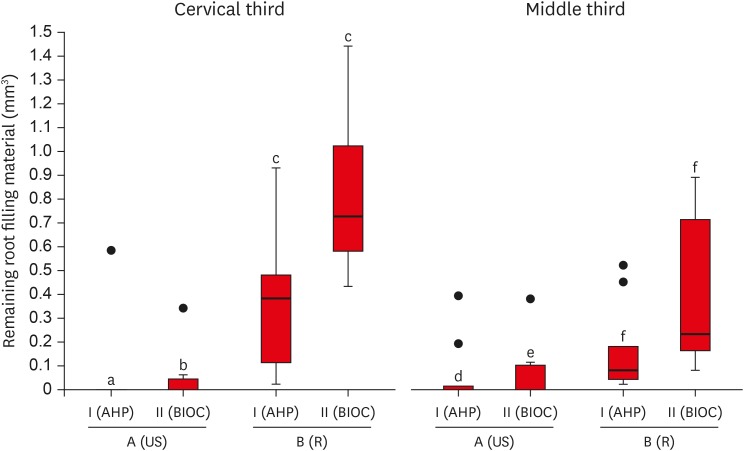1. Jiang S, Zou T, Li D, Chang JW, Huang X, Zhang C. Effectiveness of sonic, ultrasonic, and photon-induced photoacoustic streaming activation of NaOCl on filling material removal following retreatment in oval canal anatomy. Photomed Laser Surg. 2016; 34:3–10. PMID:
26682489.

2. Martinho FC, Carvalho CA, Oliveira LD, de Lacerda AJ, Xavier AC, Augusto MG, Zanatta RF, Pucci CR. Comparison of different dentin pretreatment protocols on the bond strength of glass fiber post using self-etching adhesive. J Endod. 2015; 41:83–87. PMID:
25246368.
3. Barreto MS, Rosa RA, Seballos VG, Machado E, Valandro LF, Kaizer OB, Só M, Bier C. Effect of intracanal irrigants on bond strength of fiber posts cemented with a self-adhesive resin cement. Oper Dent. 2016; 41:e159–e167. PMID:
27603176.

4. Vilas-Boas DA, Grazziotin-Soares R, Ardenghi DM, Bauer J, de Souza PO, de Miranda Candeiro GT, Maia-Filho EM, Carvalho CN. Effect of different endodontic sealers and time of cementation on push-out bond strength of fiber posts. Clin Oral Investig. 2018; 22:1403–1409.

5. Rivera-Peña ME, Duarte MA, Alcalde MP, DE Andrade FB, Vivan RR. A novel ultrasonic tip for removal of filling material in flattened/oval-shaped root canals: a microCT study. Braz Oral Res. 2018; 32:e88. PMID:
30110086.

6. Cavenago BC, Ordinola-Zapata R, Duarte MA, del Carpio-Perochena AE, Villas-Bôas MH, Marciano MA, Bramante CM, Moraes IG. Efficacy of xylene and passive ultrasonic irrigation on remaining root filling material during retreatment of anatomically complex teeth. Int Endod J. 2014; 47:1078–1083. PMID:
24456216.

7. Chen X, Liu H, He Y, Luo T, Zou L. Effects of endodontic sealers and irrigation systems on smear layer removal after post space preparation. J Endod. 2018; 44:1293–1297. PMID:
30053936.

8. Utneja S, Nawal RR, Talwar S, Verma M. Current perspectives of bio-ceramic technology in endodontics: calcium enriched mixture cement - review of its composition, properties and applications. Restor Dent Endod. 2015; 40:1–13. PMID:
25671207.

9. Kırmalı Ö, Üstün Ö, Kapdan A, Kuştarcı A. Evaluation of various pretreatments to fiber post on the push-out bond strength of root canal dentin. J Endod. 2017; 43:1180–1185. PMID:
28527844.

10. Dimitrouli M, Günay H, Geurtsen W, Lührs AK. Push-out strength of fiber posts depending on the type of root canal filling and resin cement. Clin Oral Investig. 2011; 15:273–281.

11. Fruchi Lde C, Ordinola-Zapata R, Cavenago BC, Hungaro Duarte MA, Bueno CE, De Martin AS. Efficacy of reciprocating instruments for removing filling material in curved canals obturated with a single-cone technique: a micro-computed tomographic analysis. J Endod. 2014; 40:1000–1004. PMID:
24935552.
12. Rödig T, Reicherts P, Konietschke F, Dullin C, Hahn W, Hülsmann M. Efficacy of reciprocating and rotary NiTi instruments for retreatment of curved root canals assessed by micro-CT. Int Endod J. 2014; 47:942–948. PMID:
24386931.

13. Silva EJ, Sá L, Belladonna FG, Neves AA, Accorsi-Mendonça T, Vieira VT, De-Deus G, Moreira EJ. Reciprocating versus rotary systems for root filling removal: assessment of the apically extruded material. J Endod. 2014; 40:2077–2080. PMID:
25442728.

14. Martinho FC, Freitas LF, Nascimento GG, Fernandes AM, Leite FR, Gomes AP, Camões IC. Endodontic retreatment: clinical comparison of reciprocating systems versus rotary system in disinfecting root canals. Clin Oral Investig. 2015; 19:1411–1417.

15. Coniglio I, Magni E, Cantoro A, Goracci C, Ferrari M. Push-out bond strength of circular and oval-shaped fiber posts. Clin Oral Investig. 2011; 15:667–672.

16. Schmage P, Pfeiffer P, Pinto E, Platzer U, Nergiz I. Influence of oversized dowel space preparation on the bond strengths of FRC posts. Oper Dent. 2009; 34:93–101. PMID:
19192843.

17. Muñoz C, Llena C, Forner L. Oval fiber posts do not improve adaptation to oval-shaped canal walls. J Endod. 2011; 37:1386–1389. PMID:
21924187.

18. Rechenberg DK, Paqué F. Impact of cross-sectional root canal shape on filled canal volume and remaining root filling material after retreatment. Int Endod J. 2013; 46:547–555. PMID:
23190273.

19. Cecchin D, Farina AP, Souza MA, Carlini-Júnior B, Ferraz CC. Effect of root canal sealers on bond strength of fibreglass posts cemented with self-adhesive resin cements. Int Endod J. 2011; 44:314–320. PMID:
21219360.

20. Oltra E, Cox TC, LaCourse MR, Johnson JD, Paranjpe A. Retreatability of two endodontic sealers, EndoSequence BC Sealer and AH Plus: a micro-computed tomographic comparison. Restor Dent Endod. 2017; 42:19–26. PMID:
28194360.

21. Guimarães LS, Gomes CC, Marceliano-Alves MF, Cunha RS, Provenzano JC, Siqueira JF Jr. Preparation of oval-shaped canals with TRUShape and Reciproc Systems: a micro–computed tomography study using contralateral premolars. J Endod. 2017; 43:1018–1022. PMID:
28416315.

22. Keleş A, Alcin H, Kamalak A, Versiani MA. Micro-CT evaluation of root filling quality in oval-shaped canals. Int Endod J. 2014; 47:1177–1184. PMID:
24527697.








 PDF
PDF Citation
Citation Print
Print



 XML Download
XML Download